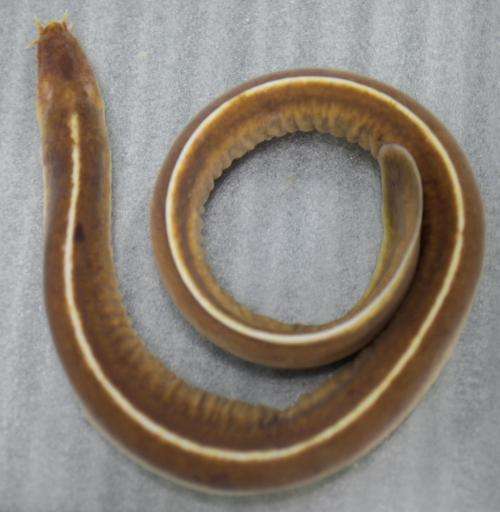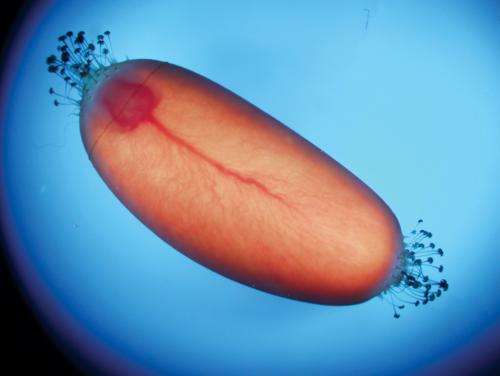Figure 1: Adult hagfish, Eptatretus burgeri, seen from dorsal view. Credit: 2013 Shigeru Kuratani, RIKEN Center for Developmental Biology
By demonstrating the close 'relatedness' of two primitive jawless fish, scientists begin to assemble a more accurate depiction of the early history of vertebrate evolution.
Roughly 500 million years ago, our ancestors began developing a physical characteristic that is almost universal among modern vertebrates: jaws. In fact, the hagfish and the lamprey are the only known living vertebrates that do not belong to this 'gnathostome' majority. These jawless 'cyclostomes' are instead generally considered to be holdovers from the earliest days of the vertebrate lineage.
Yet hagfishes and lampreys bear striking physiological differences, calling into question the closeness of their relatedness and their relative positions on the 'evolutionary tree'. New research from Shigeru Kuratani's team at the RIKEN Center for Developmental Biology now provides striking evidence that these two fish should indeed be grouped together, based on a shared process of craniofacial development that is distinct from gnathostomes.
The hagfish (Fig. 1) lacks several features that define the vertebrate body plan, with a head that looks strikingly different from the lamprey in cross-section, leading some scientists to posit that hagfishes represent a more primitive digression from the vertebrate lineage. This would mean lampreys are a separate, more direct antecedent of gnathostomes, undermining the idea that both species belong to a single offshoot group of cyclostomes.
"It is a recent trend to view each animal lineage's developmental program as diverging and differing from each other," says Kuratani, "and not viewing one specific program as ancestral to the others." To resolve this debate, Kuratani and colleagues began a deep analysis of hagfish development.
Figure 2: Growing embryo in the egg of E. burgeri, with the head visible at upper left. Credit: 2013 Shigeru Kuratani, RIKEN Center for Developmental Biology
Back to the beginning
One major developmental difference observed in hagfishes pertains to an essential endocrine gland known as the adenohypophysis. In lampreys and other vertebrates, this organ develops from an embryonic tissue called the ectoderm, while previous analyses have suggested that the hagfish adenohypophysis arises from an entirely different embryonic tissue—the endoderm. However, Kuratani was concerned about the foundations of that conclusion. "Those observations were partly based on ill-fixed samples with lots of tissue distortion, and from very few specimens," he says.
Historically, hagfish eggs have proved remarkably difficult to obtain. By working with local Japanese fishermen, however, Kuratani's team has been able to collect enough adult hagfishes to allow tissue to be cultivated in the laboratory, providing unprecedented access to freshly laid hagfish eggs (Fig. 2). This achievement has given the team valuable insights into the embryology of this enigmatic species.
Through close examination of craniofacial formation at precise timepoints in hagfish development with the aim of identifying similarities and differences relative to the lamprey and a representative gnathostome species, the cloudy catshark, Kuratani's team has made a number of important observations. For example, during an embryonic stage known as the neurula, the endoderm and ectoderm are brought into direct proximity with one another at a structure known as the oropharyngeal membrane, which ultimately forms the mouth. However, the researchers identified another membrane in the hagfish neurula that appears to be unique to this group of species, which they termed the secondary oropharyngeal membrane (SOM). They concluded that previous investigators used the wrong 'landmark', mistaking the SOM for the oropharyngeal membrane, and thereby incorrectly positioned the origin of the adenohypophysis within the endoderm. Further embryonic analysis confirmed that this gland originates in the hagfish ectoderm, as with the shark and lamprey.
Kuratani and his colleagues identified other, clear similarities in lamprey and hagfish craniofacial development. In both animals the nostril and adenohypophysis originate from a single source tissue, remaining adjacent in the mature animal. In comparison, these structures arise from two separate tissues in gnathostome species, and mature gnathostomes typically have two nostrils (rather than the one observed in cyclostomes) positioned further apart from the adenohypophysis, which is in turn connected with the mouth and throat.
Uncovering an ancestral connection
These and other findings from Kuratani's team strongly support a model in which hagfishes and lampreys belong to a common 'branch' of the evolutionary tree. "With these findings, people will be convinced that these animals are evolutionarily very close to each other," says Kuratani, "and it also helps us identify homologous organs and structures in adult animals, which is very hard with simple dissection."
Their results also offer some other interesting insights. For example, the physiological oddities that have helped confound the positioning of hagfishes on the evolutionary timeline—such as the absence of a vertebral column—suggest that this species may have actually shed certain 'advanced' features found in lampreys to accommodate its distinctive lifestyle. "Hagfishes dive into rotten bodies of whales and large fish," explains Kuratani, "and make a movable knot in their long body to pull themselves out of the body they were eating." By comparison, lampreys feed on small organisms in the water or by attaching parasitically to the exterior of other fish.
Most importantly, this embryological comparative analysis has identified potential commonalities between processes observed in cyclostome development and those seen in the most primitive gnathostomes, indicating the possibility of a shared 'basic blueprint' for head formation. "This suggests a pattern that could be regarded as ancestral for all vertebrates," concludes Kuratani. In future work, his team will continue to explore the mysteries of hagfish development, but they also intend to broaden their investigation of early evolutionary history to include the amphioxus—also known as a lancelet—which is an invertebrate that scientists see as a close precursor to the emergence of vertebrate species. "We hope to reconstruct early vertebrate evolution and the establishment of the vertebrate body plan by describing it as changes in the developmental program associated with specific genomic changes," says Kuratani.
More information: Oisi, Y. et al. Craniofacial development of hagfishes and the evolution of vertebrates. Nature 493, 170–180 (2013).dx.doi.org/10.1038/nature11794
Journal information: Nature
Provided by RIKEN


.jpg)





















